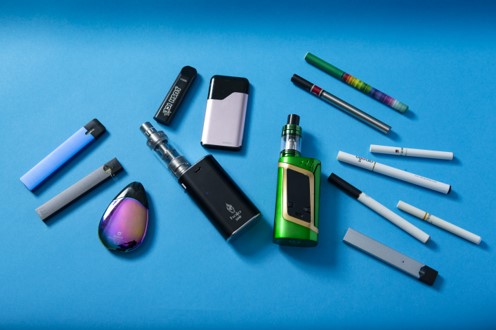E-cigarettes are the most commonly used tobacco product among middle- and high-school students.
These electronic devices, also known as e-cigarettes, vapes, vape pens, personal vaporizers, e-cigars, pod systems, mods and e-hookah, are not a safe alternative to cigarette smoking.
E-cigarettes can be hard to recognize. Not all e-cigarettes look alike, and vaping is easy to hide. Here's what parents need to know.
What are e-cigarettes?
E-cigarettes produce an aerosolized liquid (vapor) that usually contains nicotine and other chemicals inhaled by the user. This is called vaping.
The liquid solution used in e-cigarettes, sometimes called vape juice or e-liquid, usually contains nicotine and other chemicals. E-cigarettes can be used to smoke or "vape"
marijuana products, herbs, waxes and oils.
Vape "juice" or e-liquid is often flavored. This makes it appealing to children and adolescents. In fact, more than 85% of young users favor the candy, fruit and mint flavors that vape makers have formulated for their tastes.
While flavors were nationally banned in 2019, this ban excludes mint and menthol flavors. This ban excludes disposable e-cigarette devices, which are sold in many appealing flavors and are relatively inexpensive. and are now the most popular type of e-cigarette used by adolescents.
Parents, share this video with your teen:
What do e-cigarettes look like?
 E-cigarettes can be hard to recognize. They may resemble traditional tobacco products like cigarettes, cigars, pipes, or other common gadgets like pens, flashlights, USB flash drives, fidget spinners, gaming controls, car key fobs,
smart watches and even asthma inhalers. In fact, the
U.S. Food and Drug Administration has issued warnings to several companies for marketing 15 different e-cigarette products packaged to look like toys, food or cartoon characters that were likely to promote use among adolescents.
E-cigarettes can be hard to recognize. They may resemble traditional tobacco products like cigarettes, cigars, pipes, or other common gadgets like pens, flashlights, USB flash drives, fidget spinners, gaming controls, car key fobs,
smart watches and even asthma inhalers. In fact, the
U.S. Food and Drug Administration has issued warnings to several companies for marketing 15 different e-cigarette products packaged to look like toys, food or cartoon characters that were likely to promote use among adolescents.
How popular are e-cigarettes?
In 2022, e-cigarettes remained the most common tobacco product used by high school (16.5%) and middle school (4.5%) students in the last 30 days. And more than a quarter (27.6%) of current youth e-cigarette users say they use an e-cigarette product every day.
Children are exposed to e-cigarette advertising
online and on TV, in magazines and billboards. Although it is illegal for e-cigarettes to be sold to youth under age 21, they can be ordered online.
Why e-cigarettes and vaping are harmful & addictive
Nicotine side effects & future substance use
The nicotine found in most e-cigarettes is addictive and can harm brain development. The more kids vape, the harder it is for them to stop. Using nicotine in adolescence can
harm the parts of the brain that control attention, learning, mood and impulse control. Some e-cigarettes marketed as containing 0% nicotine have been found to contain nicotine.
Youth who use e-cigarettes are more likely to smoke traditional cigarettes in the future. Using nicotine in adolescence may also increase the risk for future substance use disorders.
E-liquid from e-cigarettes and refill packs
can contaminate skin, leading to nicotine poisoning. Symptoms of nicotine poisoning include vomiting, sweating, dizziness, increased heart rate, lethargy, seizures and difficulty breathing.
The most popular e-cigarettes contain highly concentrated nicotine salts that deliver much more nicotine that traditional cigarettes.
Other health harms from vaping
Beyond nicotine, the solution in e-cigarette devices and vapor contains harmful chemicals like
antifreeze (made from one of two chemicals: propylene glycol or ethylene glycol), diethylene glycol and aldehydes (like formaldehyde). Formaldehyde is ranked as one of the top cardiovascular toxins also found in cigarette smoke.
"E-juice" may also contain cancer-causing chemicals, heavy metals and ultrafine particles that can get deep into the lungs.
Secondhand smoke/vapor from e-cigarettes is harmful to growing lungs. In fact, studies show long-term effects on lung health, function and development.
In some cases, e-cigarette devices have
exploded, causing burns or fires.
Vaping & lung injury: what is EVALI?
In 2019, the U.S. Centers for Disease Control & Prevention began looking into an
outbreak of e-cigarette, or vaping, product use-associated lung injury (EVALI) or vaping-associated pulmonary injury (VAPI). By February 2020, there had been more than 2,800 hospitalizations and 68 deaths from EVALI across the United States.
Tetrahydrocannabinol (THC)-containing e-cigarette or vaping products was linked to most EVALI cases. So was Vitamin E acetate, an additive in vape cartridges e-liquids. Emergency department visits related to e-cigarette, or vaping, products have sharply declined in recent years, but the CDC continues to monitor reports.
Are e-cigarettes a good way to help quit smoking?
E-cigarettes are not recommended as a way to
quit smoking. They are not yet regulated nor approved for smoking cessation by the
U.S. Food and Drug Administration.The long-term health effects to users and bystanders are still unknown.
The best way to protect your children is to never smoke or vape near them. Talk with your doctor about quitting all tobacco. Never smoke indoors, in your car, or in places where children spend time.
Remember
It's important to help protect children and teens from using or being exposed to the harmful vapor from e-cigarettes. Talk with your pediatrician for more information about these products and keeping your child safe and healthy. Your regional Pediatric Environmental Health Specialty Unit (PEHSU) also have staff who can also talk with you about environmental toxins.
More information
Image source: S. Tanski, courtesy Dartmouth-Hitchcock. Used with permission.